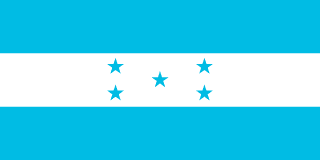Honduras - Geography

Here, let us take a look at the Geography of Honduras. Has only a short Pacific coast but a long Caribbean shoreline, including the virtually uninhabited eastern Mosquito Coast. Mother's mean age at first birth is 20.3 years (2011/12 est.) (Note: data represents median age a first birth among women 25-49), whereas, the Maternal mortality ratio is 47 deaths/100,000 live births (2023 est.)
Geographical data of Honduras
| Location | Central America, bordering the Caribbean Sea, between Guatemala and Nicaragua and bordering the Gulf of Fonseca (North Pacific Ocean), between El Salvador and Nicaragua |
|---|---|
| Geographic coordinates | 15 00 N, 86 30 W |
| Map references | Central America and the Caribbean |
| Tarrain | mostly mountains in interior, narrow coastal plains |
| Natural Resources | timber, gold, silver, copper, lead, zinc, iron ore, antimony, coal, fish, hydropower |
| Natural Hazards | frequent, but generally mild, earthquakes; extremely susceptible to damaging hurricanes and floods along the Caribbean coast |
| Irrigated Land | 900 sq km (2012) |
| Major rivers (by length in km) | |
| Major aquifers | |
| Land Boundaries | 1,575 km |
| Border Countries | Guatemala 244 km; El Salvador 391 km; Nicaragua 940 km |
| Coastline | 823 km (Caribbean Sea 669 km; Gulf of Fonseca 163 km) |
| Climate | subtropical in lowlands, temperate in mountains |
| Area | |
| Total Area | |
| Land Area | 111,890 sq km |
| Water Area | 200 sq km |
| comparative Area | slightly larger than Tennessee |
| Maritime Claims | |
| Territorial sea | 12 nm |
| Contiguous zone | 24 nm |
| Exclusive economic zone | 200 nm |
| Continental shelf | natural extension of territory or to 200 nm |
| Elevations | |
| Highest point | Cerro Las Minas 2,870 m |
| Lowest point | Caribbean Sea 0 m |
| Mean elevation | 684 m |
| Land Use | |
| Agricultural land | 32% (2023 est.) |
| Agricultural land: arable land | arable land: 9.1% (2023 est.) |
| Agricultural land: permanent crops | permanent crops: 5.4% (2023 est.) |
| Agricultural land: permanent pasture | permanent pasture: 17.5% (2023 est.) |
| Forest | 53.3% (2023 est.) |
| Other | 14.8% (2023 est.) |
Population Distribution
Most residents live in the mountainous western half of the country; Honduras is the only Central American nation with an urban population that is distributed between two large centers, the capital of Tegucigalpa and the city of San Pedro Sula; the Rio Ulua valley in the north is the only densely populated lowland area
People and Society
In Honduras, the different Ethnic groups are such that we have: Mestizo (mixed Indigenous and European) 90%, Indigenous 7%, African descent 2%, White 1%
| Population | |
|---|---|
| Pop growth rate | 1.29% (2024 est.) |
| Birth rate | 19.9 births/1,000 population (2024 est.) |
| Death rate | 5.4 deaths/1,000 population (2024 est.) |
| Health expenditure | |
| Physicians Density | |
| Hospital bed Density | 0.7 beds/1,000 population (2021 est.) |
| Total fertility rate | 2.33 children born/woman (2024 est.) |
| Gross reproduction rate | 1.15 (2024 est.) |
| Contraceptive prevalence rate | |
| Est married women (ages 15-49) | 53.5% (2023 est.) |
| Literacy | |
| Education expenditures | |
| Net Migration rate | -1.7 migrant(s)/1,000 population (2024 est.) |
| Nationality | Honduran | Honduran(s) |
| Languages | |
| Religions | Evangelical 55%, Roman Catholic 33.4%, none 10.1%, unspecified 1.5% (2023 est.) |
| Age Structure | |
| 0-14 years | 28.7% (male 1,378,026/female 1,353,238) |
| 15-64 years | 65.7% (male 2,980,393/female 3,282,159) |
| 65 years and over | 5.6% (2024 est.) (male 232,828/female 302,544) |
| Dependency Ratios | |
| Total dependency ratio | 52.2 (2024 est.) |
| Youth dependency ratio | 43.6 (2024 est.) |
| Elderly dependency ratio | 8.5 (2024 est.) |
| Potential support ratio | 11.7 (2024 est.) |
| Median Age | |
| Total | 25.7 years (2024 est.) |
| Male | 24.8 years |
| Female | 26.6 years |
| Urbanization | |
| Urban population | 60.2% of total population (2023) |
| Rate of urbanization | 2.48% annual rate of change (2020-25 est.) |
| Major urban areas (Pop) | 1.568 million TEGUCIGALPA (capital), 982,000 San Pedro Sula (2023). |
| Sex Ratio | |
| At birth | 1.03 male(s)/female |
| 0-14 years | 1.02 male(s)/female |
| 15-64 years | 0.91 male(s)/female |
| 65 years and over | 0.77 male(s)/female |
| Total population | 0.93 male(s)/female (2024 est.) |
| Infant Motality | |
| Total | 15.4 deaths/1,000 live births (2024 est.) |
| Male | 17.5 deaths/1,000 live births |
| Female | 13.2 deaths/1,000 live births |
| Life Expectancy at birth | |
| Total population | 73.1 years (2024 est.) |
| Male | 69.6 years |
| Female | 76.8 years |
| Drinking Water Sources | |
| Improved: urban | urban: 99.2% of population (2022 est.) |
| Improved: rural | rural: 90.8% of population (2022 est.) |
| Improved: total | total: 95.8% of population (2022 est.) |
| Unimproved: urban | urban: 0.8% of population (2022 est.) |
| Unimproved: rural | rural: 9.2% of population (2022 est.) |
| Unimproved: total | total: 4.2% of population (2022 est.) |
| Sanitation facility acess | |
| Improved: urban | urban: 96.6% of population (2022 est.) |
| Improved: rural | rural: 88.1% of population (2022 est.) |
| Improved: total | total: 93.2% of population (2022 est.) |
| Unimproved: urban | urban: 3.4% of population (2022 est.) |
| Unimproved: rural | rural: 11.9% of population (2022 est.) |
| Unimproved: total | total: 6.8% of population (2022 est.) |
| Alcohol consumption per capita | |
| Total | 2.73 liters of pure alcohol (2019 est.) |
| Beer | 1.6 liters of pure alcohol (2019 est.) |
| Wine | 0.04 liters of pure alcohol (2019 est.) |
| Spirits | 1.09 liters of pure alcohol (2019 est.) |
| Other alcohols | 0 liters of pure alcohol (2019 est.) |
| Tobacco use | |
| Total | 11.9% (2025 est.) |
| Male | 22.2% (2025 est.) |
| Female | 1.6% (2025 est.) |
| Child marriage | |
| Women married by age 15 | 9.2% (2019) |
| Women married by age 18 | 34% (2019) |
| Men married by age 18 | 10% (2019) |
Demographic profile
All Important Facts about Honduras
Want to know more about Honduras? Check all different factbooks for Honduras below.









